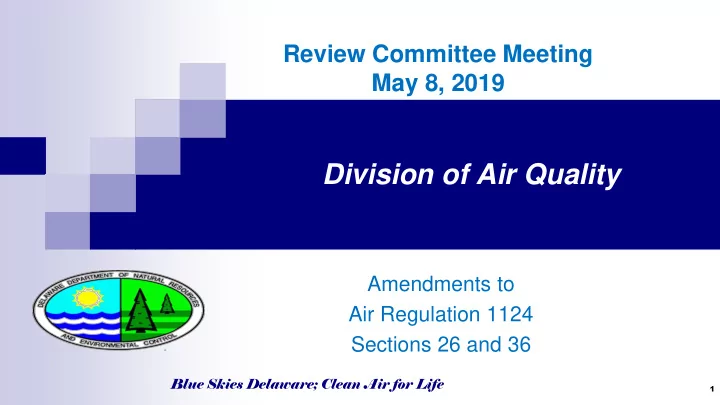

Review Committee Meeting May 8, 2019 Division of Air Quality Amendments to Air Regulation 1124 Sections 26 and 36 Blue Skies Delaware; Clean Air for Life 1
Air Regulation considered for amendments: • 7 DE Admin Code 1124 o Commonly known as “ Air Regulation 1124 ”; • Section 26 “Gasoline Dispensing Facility Stage I Vapor Recovery” o Commonly known as “ Stage I regulation ”; • Section 36 “Vapor Emission Control at Gasoline Dispensing Facilities” o Commonly known as “ Stage II regulation ”; Blue Skies Delaware; Clean Air for Life 2
Why we are doing this? Why Section 26 and Section 36? To control gasoline vapor emissions at gas stations; Why control gasoline vapor? It is contributing to formation of ozone (O 3 , i.e., smog) in air; Smog is harmful to public health and welfare; Gasoline vapor contains air toxics; Blue Skies Delaware; Clean Air for Life 3
Gas Stations with Stage I/Stage II in DE and Vehicles with ORVR system Since mid-1990s, 278 gasoline stations in DE (with throughputs >10,000 gal/mo.) installed : Regular Stage I systems; Vacuum-assist Stage II systems; In 1998, auto manufacturers produced vehicles with Onboard Refueling Vapor Recovery (ORVR) systems An additional control of vapor emissions from vehicles’ tanks during refueling; Blue Skies Delaware; Clean Air for Life 4
Gasoline vapor and its control at gasoline stations Gasoline vapor control: USTs must be vapor-tight ORVR Stage II Stage I Blue Skies Delaware; Clean Air for Life 5
Incompatibility between Stage II and ORVR ORVR system and Stage II systems are “incompatible” because of vapor pressure increase in underground storage tanks (USTs) due to fresh air into USTs; As a result, excessive gasoline vapor is emitted from USTs; Blue Skies Delaware; Clean Air for Life 6
Solve Incompatibility of Stage II and ORVR In 2019, more than 90% of the gasoline-powered vehicles are ORVR-equipped; In 2012, EPA allowed removal of Stage II control in ozone nonattainment states; but required Gasoline vapor emissions could not increase, or States could implement additional VOC controls on other sources to accommodate vapor emission increases as a result of Stage II removal; Blue Skies Delaware; Clean Air for Life 7
DE 2015 Stage II regulation revision In September 2015, DAQ adopted the 2015 amendments to Stage II regulation ( the 2015 regulation ) to allow voluntary removal of Stage II; While removing Stage II requirement, DAQ adopted additional requirements to ensure USTs to remain vapor-tight. Blue Skies Delaware; Clean Air for Life 8
Requirements in the 2015 regulation Voluntary decommission of Stage II; If decommissioning: Install Stage I Enhanced Vapor Recovery (EVR) system; and select either (1) To implement monthly inspection and annual pressure testing without pre- test fix (i.e., under “cold” condition); or (2) To install CPM (Continuous Pressure Monitoring) system; Blue Skies Delaware; Clean Air for Life 9
Stage II decommissioning in process Since 2015, 65 gas stations have decommissioned Stage II systems, including 2 stations with CPM. In addition, 29 stations are in decommissioning process. Blue Skies Delaware; Clean Air for Life 10
Amendments to Sections 26/36 Goal: To control gasoline vapor emissions at GDFs; Issues: How to solve Stage II-ORVR incompatibility? How to ensure USTs to be vapor-tight? Discussion Blue Skies Delaware; Clean Air for Life 11
Discussion: How to solve Stage II-ORVR incompatibility? Blue Skies Delaware; Clean Air for Life 12
Discussion: How to ensure USTs vapor-tight? Blue Skies Delaware; Clean Air for Life 13
Meeting summary will be emailed by May15; Send your comments via emails to by May 29: DNREC_1124_Regulations@Delaware.gov Second committee meeting: June 12, 2019; • State Street Commons, DAQ, Dover. Third meeting: July 17, 2019 Location to be determined. • For more information: https://dnrec.alpha.delaware.gov/air/permitting/under- development/ Blue Skies Delaware; Clean Air for Life
Recommend
More recommend